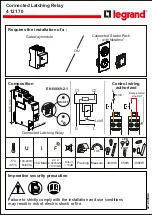
9279400990 Rev B
BE1-59NC Testing
5-1
SECTION 5
•
TESTING
INTRODUCTION
The following procedures verify proper relay operation and calibration.
Results obtained from these procedures may no fall within specified tolerances. When evaluating results,
consider three prominent factors:
•
Test equipment accuracy
•
Testing
method
•
External test set components tolerance level
REQUIRED TEST EQUIPMENT
Minimum test equipment required for relay testing and adjustment is listed below.
•
Two Multi-Amp SSR-78 and a counter/timer accurate to at least 1.0% or one Doble F2500 (has timer
included) or suitable substitute.
•
Digital voltmeter accurate to within 1% or better.
•
Variable AC/DC (0-250V) power supply (for power input).
•
DC power supply (for current operated targets).
OPERATIONAL TEST
Step 1. Perform the appropriate test setup for your relay. Use Figure 5-1 for timing option E2 and Figure
5-2 for timing options D1 or D2. On D1, setpoint one is inverse time and setpoint two is definite
time.
Step 2. Apply operating power to the relay, verify that the POWER LED is ON, and verify that the power
supply status contact is open.
Step 3. Perform the following timing tests as appropriate for your relay.
E2 Timing Option
Step 1. Reference to Figure 5-1, connect an ac voltage source (50 or 60 Hz, depending upon input
option) to case terminals 6 and 7. Adjust this voltage to equal the desired overvoltage pickup
level for OVERVOLTAGE 1.
Step 2. Starting at maximum CW, slowly turn OVERVOLTAGE 1 PICKUP adjust potentiometer R63
CCW until OVERVOLTAGE 1 PICKUP LED just illuminates.
Step 3. Set OVERVOLTAGE 1 TIME DIAL to 001 and apply to case terminals 6 and 7, a voltage that is
10% greater than the value applied in Step 1.
Step 4. Monitor the output terminals indicated in Figure 5-1 for OVERVOLTAGE 1. Remove, and then
reapply the overvoltage at case terminals 6 and 7. Observe the time registered by the counter.
Time must equal the setting
±
100 milliseconds or 2%, whichever is greater.
Step 5. Set OVERVOLTAGE 1 TIME DIAL to 010. Monitor the output terminals indicated in Figure 5-1
for OVERVOLTAGE 1. Remove, and then reapply the overvoltage at case terminals 6 and 7.
Observe the time registered by the counter. Time must equal the setting
±
100 milliseconds or
2%, whichever is greater.
Step 6. Set OVERVOLTAGE 1 TIME DIAL to 100. Monitor the output terminals indicated in Figure 5-1
for OVERVOLTAGE 1. Remove, and then reapply the overvoltage at case terminals 6 and 7.
Observe the time registered by the counter. Time must equal the setting
±
100 milliseconds or
2%, whichever is greater.
Step 7. Set OVERVOLTAGE 1 TIME DIAL to 999. Monitor the output terminals indicated in Figure 5-1
for OVERVOLTAGE 1. Remove, and then reapply the overvoltage at case terminals 6 and 7.
Observe the time registered by the counter. Time must equal the setting
±
100 milliseconds or
2%, whichever is greater.
Step 8. Adjust the voltage source equal the desired overvoltage pickup level for OVERVOLTAGE 2.
Step 9. Starting at maximum CW, slowly turn OVERVOLTAGE 2 PICKUP adjust potentiometer R43
CCW until OVERVOLTAGE 2 PICKUP LED just illuminates.
Summary of Contents for BE1-59NC
Page 2: ......
Page 6: ...iv BE1 59NC Introduction 9279400990 Rev B This page intentionally left blank...
Page 8: ...vi BE1 59NC Introduction 9279400990 Rev B This page intentionally left blank...
Page 16: ...1 8 BE1 59NC General Information 9279400990 Rev B This page intentionally left blank...
Page 22: ...4 2 BE1 59NC Installation 9279400990 Rev B Figure 4 1 Panel Cutting Drilling Semi Flush Case...
Page 30: ...4 10 BE1 59NC Installation 9279400990 Rev B Figure 4 9 Typical Protection Methods...
Page 31: ...9279400990 Rev B BE1 59NC Installation 4 11 Figure 4 10 Typical Internal Connections...
Page 38: ...5 6 BE1 59NC Testing 9279400990 Rev B This page intentionally left blank...







































